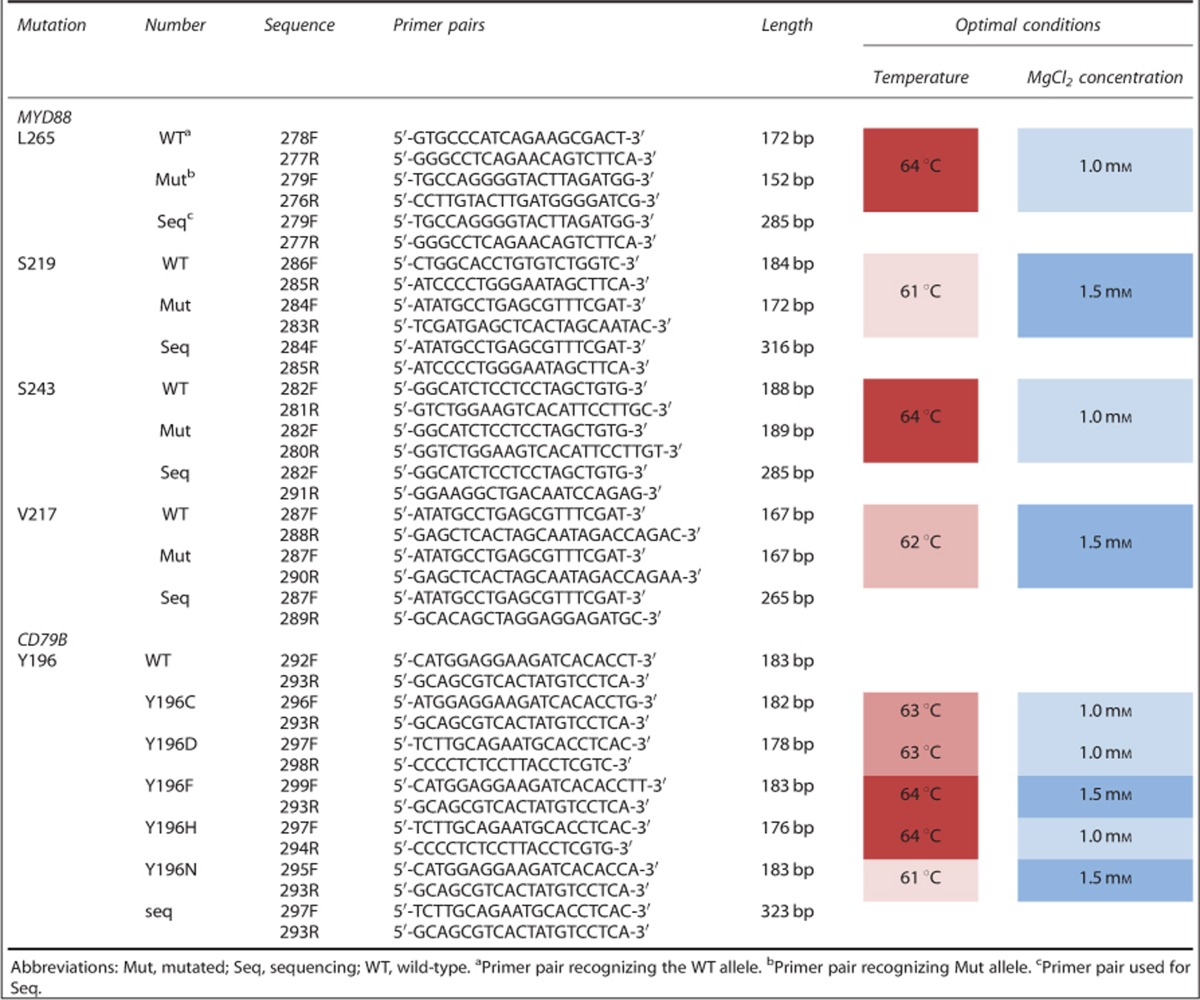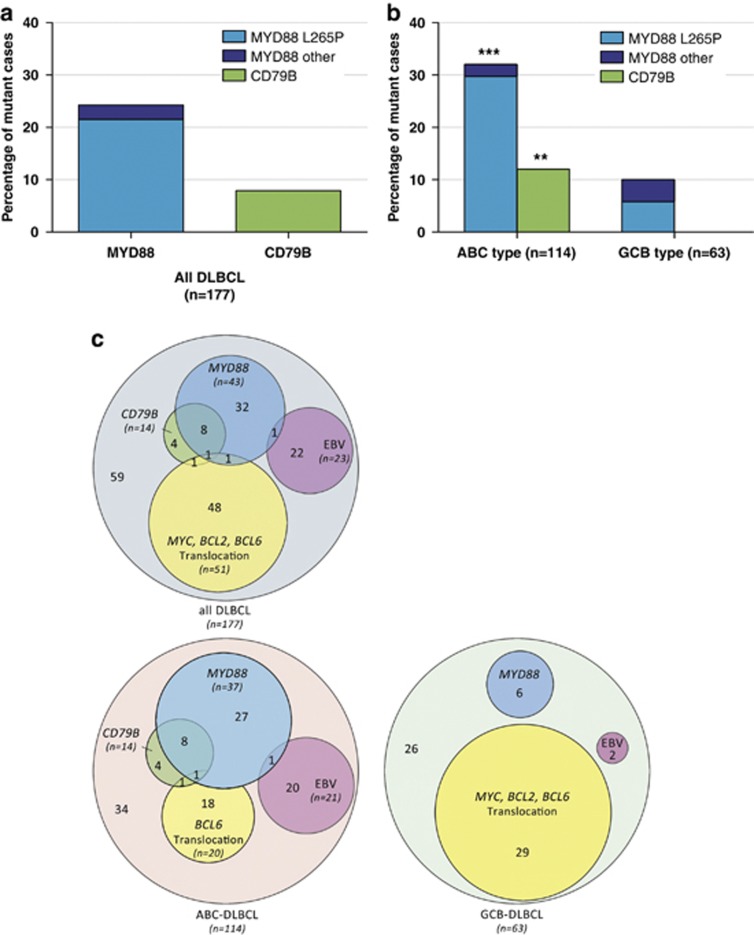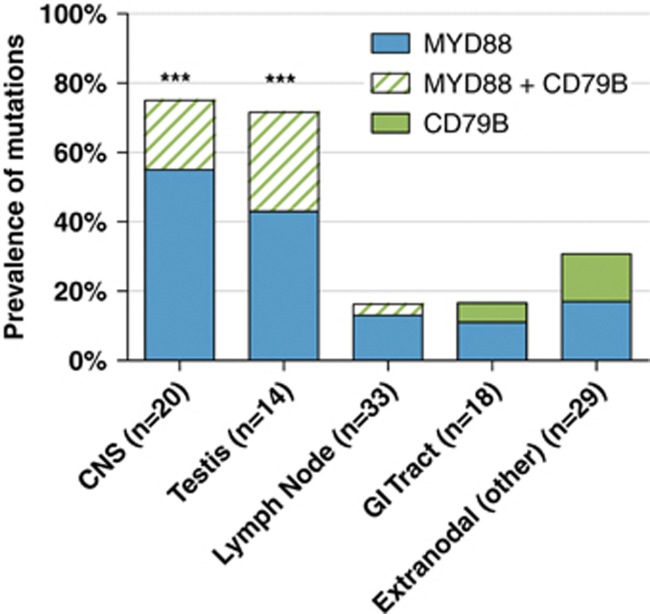Abstract
Activating mutations in CD79 and MYD88 have recently been found in a subset of diffuse large B-cell lymphoma (DLBCL), identifying B-cell receptor and MYD88 signalling as potential therapeutic targets for personalized treatment. Here, we report the prevalence of CD79B and MYD88 mutations and their relation to established clinical, phenotypic and molecular parameters in a large panel of DLBCLs. We show that these mutations often coexist and demonstrate that their presence is almost mutually exclusive with translocations of BCL2, BCL6 and cMYC, or Epstein–Bar virus infection. Intriguingly, MYD88 mutations were by far most prevalent in immune-privileged site-associated DLBCL (IP-DLBCL), presenting in central nervous system (75%) or testis (71%) and relatively uncommon in nodal (17%) and gastrointestinal tract lymphomas (11%). Our results suggest that MYD88 and CD79B mutations are important drivers of IP-DLBCLs and endow lymphoma-initiating cells with tissue-specific homing properties or a growth advantage in these barrier-protected tissues.
Keywords: DLBCL, MYD88, CD79, lymphoma
Introduction
Diffuse large B-cell lymphoma (DLBCL) is a heterogeneous diagnostic class of lymphomas comprising molecularly distinct subtypes that differ in gene expression profile, oncogenic aberrations, clinical presentation and outcome.1, 2 A current gene expression profile-based molecular classification of DLBCL distinguishes two main subtypes: activated B-cell-like (ABC) lymphoma and germinal centre B-cell-like lymphoma. The antiapoptotic nuclear factor-kB signalling pathway is constitutively active in ABC-type DLBCLs as a result of oncogenic CARD11 mutations and/or of CD79 mutations causing chronic active B-cell receptor (BCR) signalling enhanced by inactivation of A20.3, 4, 5, 6 In addition, somatically acquired mutations in MYD88, an adaptor protein that mediates toll-like receptor and interleukin-1 receptor signalling were recently shown to control cell survival in this lymphoma type by promoting NF-κB and Janus Kinase (JAK)/ Signal transducer and activator of transcription 3 (STAT3) signalling. These mutations were present in approximately one-third of ABC DLBCLs. The MYD88 L265P was biologically the most potent mutant and was unique in its ability to organize a stable signalling complex containing phosphorylated IRAK1, which was suggested to account for its high prevalence in lymphomas.7 From a therapeutic perspective, the above findings are of great interest as they not only identify BCR and MYD88 signalling as potential therapeutic targets but also provide a genetic tool to identify patients that may benefit from personalized treatment targeting these pathways.
These notions prompted us to explore the prevalence of CD79B and MYD88 mutations and their relation to established clinical, phenotypic and molecular parameters in a large panel of DLBCL patients.
Materials and methods
Patient samples
The study comprises a panel of 177 DLBCLs diagnosed according to the WHO (World Health Organization) classification. All tissue samples were obtained during standard diagnostic procedures at the Academic Medical Center Amsterdam, The Netherlands and affiliated hospitals, and the University Medical Center Groningen, The Netherlands in accordance with the local institutional board requirements and the Declaration of Helsinki.
Immunohistochemical studies and fluorescence in situ hybridization
Immunohistochemical stainings were performed on formalin-fixed paraffin-embedded sections with the following antibodies: CD10 (Thermo Fisher Scientific, Rockford, IL, USA clone 56C6), MUM1 (clone MUM1p, DAKO), BCL2 (clone 124, DAKO, Glostrup, Denmark), BCL6 (clone PG-B6p, DAKO) using a Labvision Autostainer 480S (Thermo Fisher Scientific).
Expression of the Epstein–Barr virus (EBV) in tumour was determined by EBV-encoded RNA in situ hybridization probes (Biogenex, Fremont, CA, USA).
Split-fluorescence in situ hybridization for BCL2, BCL6 and cMYC was performed using probes and a fluorescence in situ hybridization accessory kit according to the manufacturer's recommendations (DAKO).
Mutation analysis
DNA was isolated with the QIAamp DNA Micro kit (Qiagen, Venlo, The Netherlands) according to the manufacturer's instructions. Screening for MYD88 and CD79B mutations was performed with allele-specific PCR assays, employing primers that were designed (Table 1) to specifically anneal with their 3′-terminal nucleotide to either the mutated or wild-type base. This technique allows reproducible detection of as little as 1% tumour DNA diluted in wild-type DNA (Supplementary Figure 1). To avoid aspecific binding of the primer pairs designed for the mutated to the wild-type allele, and vice versa, every set was tested at temperatures ranging from 60 to 64 °C and with different concentrations of MgCl2. To avoid underdetection of mutations in samples with low tumour load, 100 ng of DNA was used in each PCR reaction to obtain sufficient DNA originating from the tumour to detect a potential mutation. In all samples in which a PCR product was obtained using the mutation-specific primers, the region surrounding the mutation was analysed by Sanger sequencing to verify the presence of a mutation. For cases with low tumour load, PCR products were cloned before sequencing.
Table 1. Primer sequences and PCR conditions.

Results
The lymphomas included in this study were diagnosed as DLBCL according to the WHO criteria. As part of the routine diagnostic workup, all cases were subclassified as either ABC- or GC-like by employing the immunohistochemical algorithm of Hans et al.8 In addition, a systematic molecular characterization consisting of cMYC, BCL2 and BCL6 translocation analysis employing fluorescence in situ hybridization, and assessment of EBV status by EBV-encoded RNA in situ hybridization, were routinely performed. To detect somatic mutations in MYD88 or CD79B, we designed a panel of allele-specific PCRs covering all major mutation (hot)spots previously reported6, 7 (Table 1). This strategy permits efficient and sensitive detection of mutations using DNA extracted from paraffin-embedded tissue, even in samples with relatively low tumour load (Supplementary Figure 1). The detected mutations were verified by Sanger sequencing.
Of the total group of 177 DLBCL, 43 (24.3%) were found to contain a MYD88 mutation (Figure 1a). In accordance with the study of Ngo et al.,7 these mutations were predominantly present in ABC-type DLBCL (Figure 1b), occurring in 32.5% of ABC DLBCLs (Figure 1b) as opposed to only 9.5% of GBC DLBCL, and the L265P mutation was by far the most common mutation. Similarly, CD79B mutations were also predominantly found in ABC DLBCL (12.2% in ABC DLBCL vs 0% in germinal centre B-cell-like DLBCL); in more than half of these tumours, a coexisting MYD88 mutation was found. Molecular correlation revealed that the presence of MYD88 and/or CD79B mutations showed hardly any overlap with the occurrence of cMYC and BCL2 translocations; as expected, these translocations were largely restricted to the germinal centre B-cell-like DLBCL subgroup (Figure 1c). Further, EBV infection, which activates nuclear factor-kB by signals through latent membrane protein-1 and -2, instigating an ABC phenotype, and translocation of BCL6, which is present in a subgroup of ABC DLBCLs, also hardly overlapped with the occurrence of MYD88 and CD79B mutations (Figure 1c). Taken together, these observations imply that DLBCL with mutations in MYD88 represent a separate subgroup of DLBCLs with a distinct molecular pathogenesis. Consistent with this notion, our study reveals a salient site-specific variation in the prevalence of MYD88 mutations: they were relatively uncommon in ABC DLBCLs arising in lymph nodes (17%) or gut (11%), whereas tumours arising outside these ‘professional' lymphoid tissues frequently contained these mutations, either with or without a coexisting CD79B mutation. Interestingly, these MYD88 mutations were by far most prevalent in primary central nervous system (75%) and testicular lymphomas (71%), which represent the immune-privileged site-associated DLBCLs (IP-DLBCLs; Figure 2).
Figure 1.
Prevalence of MYD88 and CD79B mutations in DLBCL. (a) Percentage of DLBCL with MYD88 and/or CD79B mutations in all DLBCLs tested (n=177). (b) Percentage of tumours with MYD88 and/or CD79B mutations in ABC-type and germinal centre B-cell (GCB)-type DLBCL. Prevalence of MYD88 and CD79 mutations in ABC DLBCL was significantly different from that in GC DLBCL (**P<0.01; ***P<0.001 by Fisher's exact test). (c) Overlap of MYD88 and CD79B mutations with other recurrent oncogenic events in DLBCL.
Figure 2.
Prevalence of mutations in MYD88 and CD79B by tumour localization. Percentage of ABC DLBCL with MYD88 and/or CD79B mutations at different anatomical sites. Prevalence of MYD88 mutations in central nervous system (CNS) and testis was significantly different from that in the lymph node and gastrointestinal (GI) tract (***P<0.001 by Fisher's exact test).
Discussion
Our study confirms the previous finding that MYD88 and CD79B mutations are predominantly present in ABC-type DLBCL and often coexist within the same tumour.7 Moreover, it reveals that these mutations only rarely coexist with translocations of BCL2, BCL6 and cMYC or with EBV infection, and that they intriguingly are strongly over-represented in lymphomas presenting outside ‘professional' lymphoid tissues, particularly in so-called IP-DLBCL arising in the CNS and testis.
IP-DLBCLs have previously been shown to share a number of distinctive clinical and biological features. Besides having a relatively poor prognosis with preferential dissemination to other immune-privileged sites,9, 10, 11 these tumours are predominantly of the ABC subtype12, 13 and show prominent loss of human leukocyte antigen class I and II expression, often caused by small interstitial deletions of chromosome 6p21.3.14, 15 This is associated with the downregulation of many immune-associated genes.12 Our current finding that most IP-DLBCLs harbour a MYD88 mutation, while these mutations are uncommon in the nodal and gastrointestinal tract DLBCLs, supports the concept that IP-DLBCLs present a pathogenetically distinct group of lymphomas. Consistent with this notion, two other studies have recently also reported a high frequency of MYD88 mutations in primary central nervous systems.16, 17 Conceivably, mutational activation of toll-like receptor/MYD88 signalling endows lymphoma-initiating cells with a selective growth advantage at immune-privileged sites. These tissues are barrier-protected and immunologically silent, and, in marked contrast to lymph nodes and mucosa-associated lymphoid tissues, will presumably provide only limited stimulation by toll-like receptor ligands. The (concomitant) presence of CD79B (or other BCR pathway) mutations, causing chronic active BCR signalling, may further promote the selective outgrowth of the tumour cells within these relatively stimulus poor microenvironments. In view of the pivotal role of adhesion and chemokine receptors in tissue-specific lymphoma dissemination,18, 19 dysregulated ‘homing' of lymphoma cells carrying oncogenic MYD88 and/or CD79 mutations could present an alternative mechanism underlying the observed site-specific differences in prevalence of these mutations in DLBCL.18
In conclusion, our results suggest that MYD88 mutations, and to a lesser extent CD79B mutations, are important drivers of lymphomagenesis in IP-DLBCLs. Hence, patients with these tumours may benefit from therapies targeting MYD88 signalling components like the IRAK4 kinase inhibitors, either alone or in combination with drugs blocking key mediators of BCR signalling such as Bruton's tyrosine kinase.19, 20 It will be of interest to explore whether or not patients with DLBCLs arising in lymph nodes and mucosa-associated lymphoid tissue and lacking these mutations, nevertheless, also show evidence of active MYD88 and/or BCR signalling. Such activation might be triggered by environmental ligands and be associated with non-oncogene addiction to these pathways.
Acknowledgments
We thank Drs Jan J Weening, AH Mulder, I Ambrose and RH van Rijssel for providing tissue samples. This study was supported by a grant from the Dutch Cancer Society.
The authors declare no conflict of interest.
Footnotes
Supplementary Information accompanies this paper on Blood Cancer Journal website (http://www.nature.com/bcj)
Supplementary Material
References
- Alizadeh AA, Eisen MB, Davis RE, Ma C, Lossos IS, Rosenwald A, et al. Distinct types of diffuse large B-cell lymphoma identified by gene expression profiling. Nature. 2000;403:503–511. doi: 10.1038/35000501. [DOI] [PubMed] [Google Scholar]
- Staudt LM, Dave S. The biology of human lymphoid malignancies revealed by gene expression profiling. Adv Immunol. 2005;87:163–208. doi: 10.1016/S0065-2776(05)87005-1. [DOI] [PMC free article] [PubMed] [Google Scholar]
- Lenz G, Davis RE, Ngo VN, Lam L, George TC, Wright GW, et al. Oncogenic CARD11 mutations in human diffuse large B cell lymphoma. Science. 2008;319:1676–1679. doi: 10.1126/science.1153629. [DOI] [PubMed] [Google Scholar]
- Compagno M, Lim WK, Grunn A, Nandula SV, Brahmachary M, Shen Q, et al. Mutations of multiple genes cause deregulation of NF-kappaB in diffuse large B-cell lymphoma. Nature. 2009;459:717–721. doi: 10.1038/nature07968. [DOI] [PMC free article] [PubMed] [Google Scholar]
- Kato M, Sanada M, Kato I, Sato Y, Takita J, Takeuchi K, et al. Frequent inactivation of A20 in B-cell lymphomas. Nature. 2009;459:712–716. doi: 10.1038/nature07969. [DOI] [PubMed] [Google Scholar]
- Davis RE, Ngo VN, Lenz G, Tolar P, Young RM, Romesser PB, et al. Chronic active B-cell-receptor signalling in diffuse large B-cell lymphoma. Nature. 2010;463:88–92. doi: 10.1038/nature08638. [DOI] [PMC free article] [PubMed] [Google Scholar]
- Ngo VN, Young RM, Schmitz R, Jhavar S, Xiao W, Lim KH, et al. Oncogenically active MYD88 mutations in human lymphoma. Nature. 2011;470:115–119. doi: 10.1038/nature09671. [DOI] [PMC free article] [PubMed] [Google Scholar]
- Hans CP, Weisenburger DD, Greiner TC, Gascoyne RD, Delabie J, Ott G, et al. Confirmation of the molecular classification of diffuse large B-cell lymphoma by immunohistochemistry using a tissue microarray. Blood. 2004;103:275–282. doi: 10.1182/blood-2003-05-1545. [DOI] [PubMed] [Google Scholar]
- Fonseca R, Habermann TM, Colgan JP, O'Neill BP, White WL, Witzig TE, et al. Testicular lymphoma is associated with a high incidence of extranodal recurrence. Cancer. 2000;88:154–161. doi: 10.1002/(sici)1097-0142(20000101)88:1<154::aid-cncr21>3.0.co;2-t. [DOI] [PubMed] [Google Scholar]
- Zucca E, Conconi A, Mughal TI, Sarris AH, Seymour JF, Vitolo U, et al. Patterns of outcome and prognostic factors in primary large-cell lymphoma of the testis in a survey by the International Extranodal Lymphoma Study Group. J Clin Oncol. 2003;21:20–27. doi: 10.1200/JCO.2003.11.141. [DOI] [PubMed] [Google Scholar]
- Schlegel U, Schmidt-Wolf IG, Deckert M. Primary CNS lymphoma: clinical presentation, pathological classification, molecular pathogenesis and treatment. J Neurol Sci. 2000;181:1–12. doi: 10.1016/s0022-510x(00)00385-3. [DOI] [PubMed] [Google Scholar]
- Booman M, Douwes J, Glas AM, de Jong D, Schuuring E, Kluin PM. Primary testicular diffuse large B-cell lymphomas have activated B-cell-like subtype characteristics. J Pathol. 2006;210:163–171. doi: 10.1002/path.2033. [DOI] [PubMed] [Google Scholar]
- Camilleri-Broet S, Criniere E, Broet P, Delwail V, Mokhtari K, Moreau A, et al. A uniform activated B-cell-like immunophenotype might explain the poor prognosis of primary central nervous system lymphomas: analysis of 83 cases. Blood. 2006;107:190–196. doi: 10.1182/blood-2005-03-1024. [DOI] [PubMed] [Google Scholar]
- Riemersma SA, Jordanova ES, Schop RF, Philippo K, Looijenga LH, Schuuring E, et al. Extensive genetic alterations of the HLA region, including homozygous deletions of HLA class II genes in B-cell lymphomas arising in immune-privileged sites. Blood. 2000;96:3569–3577. [PubMed] [Google Scholar]
- Booman M, Szuhai K, Rosenwald A, Hartmann E, Kluin-Nelemans H, de JD, et al. Genomic alterations and gene expression in primary diffuse large B-cell lymphomas of immune-privileged sites: the importance of apoptosis and immunomodulatory pathways. J Pathol. 2008;216:209–217. doi: 10.1002/path.2399. [DOI] [PubMed] [Google Scholar]
- Gonzalez-Aguilar A, Idbaih A, Boisselier B, Habbita N, Rossetto M, Laurenge A, et al. Recurrent mutations of MYD88 and TBL1XR1 in primary central nervous system lymphomas. Clin Cancer Res. 2012;18:5203–5211. doi: 10.1158/1078-0432.CCR-12-0845. [DOI] [PubMed] [Google Scholar]
- Montesinos-Rongen M, Godlewska E, Brunn A, Wiestler OD, Siebert R, Deckert M. Activating L265P mutations of the MYD88 gene are common in primary central nervous system lymphoma. Acta Neuropathol. 2011;122:791–792. doi: 10.1007/s00401-011-0891-2. [DOI] [PubMed] [Google Scholar]
- Pals ST, de Gorter DJ, Spaargaren M. Lymphoma dissemination: the other face of lymphocyte homing. Blood. 2007;119:2590–2594. doi: 10.1182/blood-2007-05-075176. [DOI] [PubMed] [Google Scholar]
- de Rooij MF, Kuil A, Geest CR, Eldering E, Chang BY, Buggy JJ, et al. The clinically active BTK inhibitor PCI-32765 targets B-cell receptor- and chemokine-controlled adhesion and migration in chronic lymphocytic leukemia. Blood. 2012;119:2590–2594. doi: 10.1182/blood-2011-11-390989. [DOI] [PubMed] [Google Scholar]
- Lim KH, Romero DL, Chaudhary D, Robinson SD, Staudt LM. IRAK4 kinase novel therapeutic target in the ABC subtype of diffuse large B cell lymphoma. ASH Annual Meeting Abstracts. 2012;120:62. [Google Scholar]
Associated Data
This section collects any data citations, data availability statements, or supplementary materials included in this article.




